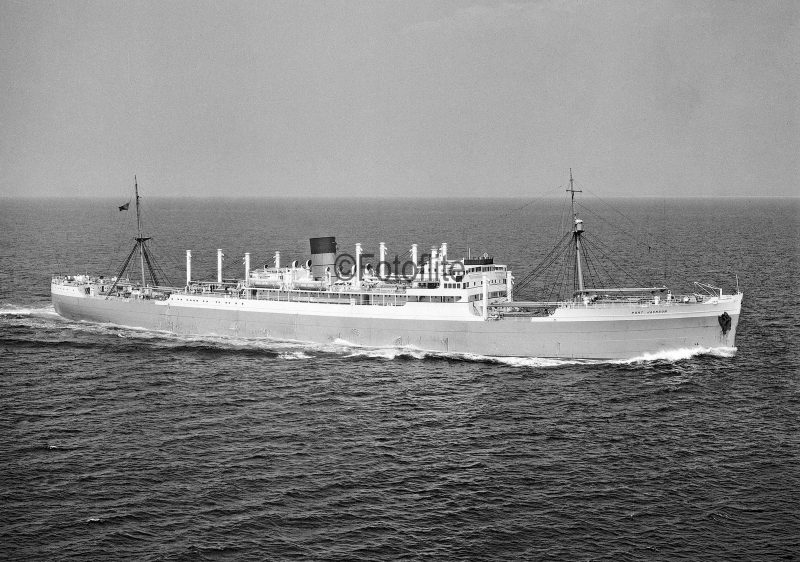
 The twin screw passenger cargo-liner Port Jackson was memorable for two reasons, firstly she was the first ship in the Port Line fleet to have a continuous long Bridge Deck, and secondly her design set a standard and was used as the prototype of eight further sisters or similar ships. She was named after the inlet on the east coast of Australia that Capt. Cook discovered in 1770, but he sailed on to conduct his surveying work further down the coast to Botany Bay, and it was left to Capt. Philip eighteen years later to venture into the inlet and discover Sydney Harbour with his big contingent of eleven ships carrying marines, settlers and convicts. This ‘First Fleet’ had sailed from Portsmouth on 13th May 1787 and dropped anchor in Sydney Cove on 26th January 1788, and was escorted by two Royal Navy ships, Sirius and Supply. The convict ships were Alexander, Charlotte, Friendship, Lady Penrhyn, Prince of Wales and Scarborough, and the store ships were Borrowdale, Fishburn and Golden Grove.
The twin screw passenger cargo-liner Port Jackson was memorable for two reasons, firstly she was the first ship in the Port Line fleet to have a continuous long Bridge Deck, and secondly her design set a standard and was used as the prototype of eight further sisters or similar ships. She was named after the inlet on the east coast of Australia that Capt. Cook discovered in 1770, but he sailed on to conduct his surveying work further down the coast to Botany Bay, and it was left to Capt. Philip eighteen years later to venture into the inlet and discover Sydney Harbour with his big contingent of eleven ships carrying marines, settlers and convicts. This ‘First Fleet’ had sailed from Portsmouth on 13th May 1787 and dropped anchor in Sydney Cove on 26th January 1788, and was escorted by two Royal Navy ships, Sirius and Supply. The convict ships were Alexander, Charlotte, Friendship, Lady Penrhyn, Prince of Wales and Scarborough, and the store ships were Borrowdale, Fishburn and Golden Grove.

The cargo-liner Port Jackson was launched at the Wallsend yard of Swan, Hunter and Wigham Richardson Ltd. on 26th November 1936 as Yard number 1515 and completed in January 1937. She had dimensions of length 521.2 feet overall, length between perpendiculars of 495.6 feet, moulded beam of 68.3 feet, depth to Upper Deck of 41.6 feet, and loaded draft of 28.6 feet. The long continuous Bridge Deck was of length 231.0 feet, with a fo’c’stle of length 93.0 feet, and a poop of length 27.0 feet. Six cavernous holds, five of them insulated together with their Lower and Upper ‘tween decks for the carriage of refrigerated cargo, had a capacity for 743,030 cubic feet of cargo (grain), of which 494,000 cubic feet was refrigerated for perishable cargoes.
Gross tonnage worked out at 9,687 with a deadweight of 10,905 tonnes, and with a useful service speed of 16.5 knots, she entered the Australian service of her owners Port Line, better known at this time as the Commonwealth and Dominion Line (C & D) and formed on 23rd January 1914.
C & D was a merger of four companies with William Milburn of Newcastle supplying nine ships with ‘Port’ prefixes to their names from his Anglo-Australasian Steam Navigation Co. Ltd., J. P. Corry of Belfast supplying 5 ships from his Star Line, Thomas B. Royden of Liverpool supplying 3 ships from his Indra Line, and G. D. Tyser & Company of London supplying eight ships as well as one of the most beautiful white, red and blue houseflags ever seen on British ships. The company name of Port Line was changed from the Commonwealth and Dominion Line on 18th November 1937, after Port Jackson had been in service for eleven months.

Design and Specification
Port Jackson had excellent accommodation for a dozen First Class passengers in six double staterooms, all tastefully furnished in a deckhouse at the forward end of Boat Deck. The staterooms contained two single beds, with two dark stained ‘tallboys’ for hanging clothes on either side of a low table containing six drawers, three on each side, with a mirror above.
The fabric of the curtains and the upholstery of the carver easy chairs was light coloured and matching. The public rooms comprised the Dining Room, Lounge and Card Room on Promenade Deck, all beautifully decorated and fitted out as follows:-
Dining Room was entered by stairs from the deck above through two glass doors with thin wooden side frames. The tables were arranged for six or four passengers with low side serving tables for the stewards and arranged with cutlery in several drawers below. This elegant room was kept cool in tropical latitudes by cooling fans on the ceiling.
Lounge was a very elegant room entered by stairs from the deck above through two glass doors with thin wooden side frames and horizontal beeding. Partitioned areas for privacy of groups of passengers were provided by further sets of double glass doors. The wooden tables had small ‘pull out’ extensions for holding drinking glasses on each of their sides, and the light oak panelling, wall mirrors, and wall clocks gave the room a cosy, intimate feel for long periods of occupancy.
Card Room and Reading and Writing Room was furnished with small writing desks at the sides lit by thin horizontal lamps. The glass doors with thin wooden frames at their sides, dark oak panelling, and comfortable carver chairs gave the room an appearance that was exactly what was required for card games, reading or writing home.

Subscribe today to read the full article!
Simply click below to subscribe and not only read the full article instantly, but gain unparalleled access to the specialist magazine for shipping enthusiasts.





Comments
Sorry, comments are closed for this item